Allowing for the fact that mushroom growing is often about the beauty of the random and the unique, there are certainly some mushroom varieties you can cultivate happily with minimum fuss and technique. All you need is shade, moisture and time, and pretty soon you’ll be rewarded with some extraordinary culinary creations. It can take anything from a few months to a year or more for the first fruits of your labor, so you will have to be patient. Other than that, it’s all about picking the right variety for the job. Here, we round up the best mushrooms for logs, so you can be sure of a host of tasty, fleshy treats.
5 Best Fungi When Growing Mushrooms On Logs
The best fungi to grow on logs rely on a dark, damp environment and a natural proclivity for the conditions that wood can provide. There are some mushroom types, such as portobello and button, which are happiest growing in compost. But those featured below will happily flourish on hardwood logs. Choosing the right logs for growing mushrooms is important. Oaks and hard maples, for instance, have a dense consistency, which suits these mushroom types. They also contain a high concentration of nutrients favored by the following fungi, allowing for more generous harvests over a greater number of years. Make sure the wood is as fresh as possible, and inoculate the log within a few weeks (ideally, two weeks is preferred so conditions are as sterile as possible). You can buy plugs already impregnated with spawn for inserting into the log. Leave logs in a shady, damp corner. If you use log kits, follow any mushroom log instructions carefully. Then monitor humidity and airflow levels, and saturate with water regularly for the best results. Below are the most resilient and adaptable varieties for growing mushrooms on logs.
1. Shiitake
Shiitake mushrooms are lovely options for beginners, and are especially suited to life growing on logs. They have a fabulously meaty texture and a buttery, earthy taste. Shiitake (Lentinula edodes) are generally considered some of the easiest to grow on logs because they are aggressive and can develop in a relatively broad range of temperatures. High-density log types will generally guarantee the most fruitful returns. Growing shiitake mushrooms on logs can take several months at the beginning, and it isn’t unusual for the first harvests to take a couple of years, so don’t lose heart. Shiitake fungi are great for drying, which means they are easy to store once harvested. They have a long shelf life, too, and can fruit for as long as eight years. Grow with: Oak, beech, hornbeam, sweet gum and hard maple.
2. Lion’s Mane
Lion’s mane is an easygoing mushroom variety that works well for log growing. These distinctively spherical mushrooms with their long, fluffy gills fruit readily. Also known as bearded hedgehog or old man’s beard, lion’s mane (Hericium erinaceus) is often described as having a taste and texture comparable to lobster. As long as you pick the right type of log, these mushrooms are reliable producers during the fall months. If you’re after the fastest fruits, lion’s mane might not be the obvious place to start, as they can take between 12-36 months to harvest. Still, they are well worth your time, with their delicious, subtle flavors. Choose the largest logs possible, and they achieve impressively large sizes (up to 16in/40cm), so they can be sliced into generous discs for pan frying. Grow with: Beech, hornbeam, hard maple, mulberry and oak.
3. Oyster
Creating oyster mushroom logs can be a lot of fun, and there are stacks of oyster varieties to play with, including Italian, king, pearl, snow, yellow, blue and pink. Mild and sweet, these fat and frilly fungi beasts can be enjoyed raw or cooked, making them surprisingly versatile in the kitchen. And while they are commonly grown using coffee grounds, they are ideal choices for log-based activity, as long as you use hardwood varieties. Hardy and relatively quick to develop, they are also adaptable to temperatures from 50-86°F (10-30°C). When you grow oysters (Pleurotus ostreatus), you’ll find they are vigorous and can develop rapidly if exposed to the right (warm and humid) conditions. Indeed, pink oysters have been known to reach maturity in just a month. With flavors ranging from seafood (snow) and nutty (yellow) to licorice (Italian), oysters offer a broad base of fascinating culinary pleasures. Grow with: Beech, hard maple, oak, mulberry, willow, birch and hornbeam.
4. Chicken of the Woods
Chicken of the woods looks like something from another planet, but is one of the most fun and flavorsome fungi you can try. Perhaps unsurprisingly, it is said to taste a bit like chicken. Growing chicken of the woods (Laetiporus sulphureus) on logs is slightly trickier in terms of log selection, and they are generally happiest with oak. Whatever you do, make sure the log you use is a healthy, fresh, sterile specimen. It’s also a good idea to ‘bag’ your log after inoculation and partially bury it for the best results. You will find that mushroom harvesting with this variety can take months from starting, but it is well worth your time. Grow with: Oak, though you could also try to grow it using green ash.
5. Chestnut
As well as being a delectable edible, chestnuts have a charming speckled appearance and a velvety texture. Growing mushrooms on logs is highly enjoyable, assuming the log selection is fresh and sterile. Chestnut mushrooms (Pholiota adiposa) can be grown on a range of tree types, including birch, hard maple and oak. As with chicken of the woods, it’s a good idea to partially bury the logs following colonization. This helps retain satisfactory levels of moisture. Chestnuts are generally considered to be best for mushroom growers who have experience growing one or two of the ‘easier’ types (like shiitake or oyster) on logs. Grow with: Birch, hard maple, oak, sweet gum, ash, cherry, hornbeam, mulberry and willow. Time and patience are also significant factors, even if you are using dedicated mushroom log kits and ‘easy mushroom’ types. The amount of lignin (essentially food) in the wood can slow things down. Oysters can be quick off the blocks, but this is not true for all types. Remember, all good things come to those who wait. Unless you are sure you have correctly identified your foraged fungi as safe, it is best to leave well enough alone. Those to be admired only from a safe distance include Amanita fungi like panther cap and death cap, which can both grow from wood.
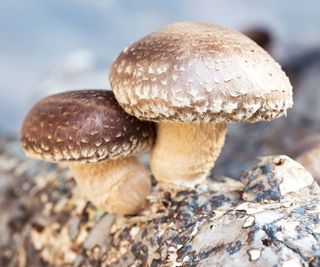
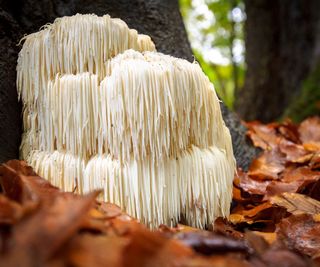
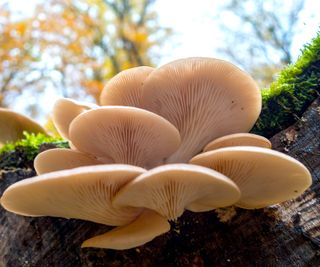
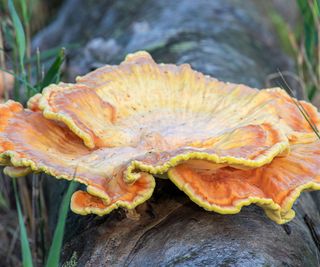
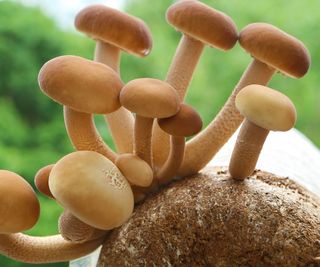
title: “Five Of The Best Fungi For Growing Mushrooms On Logs” ShowToc: true date: “2024-10-06” author: “Stephen Bilger”
Allowing for the fact that mushroom growing is often about the beauty of the random and the unique, there are certainly some mushroom varieties you can cultivate happily with minimum fuss and technique. All you need is shade, moisture and time, and pretty soon you’ll be rewarded with some extraordinary culinary creations. It can take anything from a few months to a year or more for the first fruits of your labor, so you will have to be patient. Other than that, it’s all about picking the right variety for the job. Here, we round up the best mushrooms for logs, so you can be sure of a host of tasty, fleshy treats.
5 Best Fungi When Growing Mushrooms On Logs
The best fungi to grow on logs rely on a dark, damp environment and a natural proclivity for the conditions that wood can provide. There are some mushroom types, such as portobello and button, which are happiest growing in compost. But those featured below will happily flourish on hardwood logs. Choosing the right logs for growing mushrooms is important. Oaks and hard maples, for instance, have a dense consistency, which suits these mushroom types. They also contain a high concentration of nutrients favored by the following fungi, allowing for more generous harvests over a greater number of years. Make sure the wood is as fresh as possible, and inoculate the log within a few weeks (ideally, two weeks is preferred so conditions are as sterile as possible). You can buy plugs already impregnated with spawn for inserting into the log. Leave logs in a shady, damp corner. If you use log kits, follow any mushroom log instructions carefully. Then monitor humidity and airflow levels, and saturate with water regularly for the best results. Below are the most resilient and adaptable varieties for growing mushrooms on logs.
1. Shiitake
Shiitake mushrooms are lovely options for beginners, and are especially suited to life growing on logs. They have a fabulously meaty texture and a buttery, earthy taste. Shiitake (Lentinula edodes) are generally considered some of the easiest to grow on logs because they are aggressive and can develop in a relatively broad range of temperatures. High-density log types will generally guarantee the most fruitful returns. Growing shiitake mushrooms on logs can take several months at the beginning, and it isn’t unusual for the first harvests to take a couple of years, so don’t lose heart. Shiitake fungi are great for drying, which means they are easy to store once harvested. They have a long shelf life, too, and can fruit for as long as eight years. Grow with: Oak, beech, hornbeam, sweet gum and hard maple.
2. Lion’s Mane
Lion’s mane is an easygoing mushroom variety that works well for log growing. These distinctively spherical mushrooms with their long, fluffy gills fruit readily. Also known as bearded hedgehog or old man’s beard, lion’s mane (Hericium erinaceus) is often described as having a taste and texture comparable to lobster. As long as you pick the right type of log, these mushrooms are reliable producers during the fall months. If you’re after the fastest fruits, lion’s mane might not be the obvious place to start, as they can take between 12-36 months to harvest. Still, they are well worth your time, with their delicious, subtle flavors. Choose the largest logs possible, and they achieve impressively large sizes (up to 16in/40cm), so they can be sliced into generous discs for pan frying. Grow with: Beech, hornbeam, hard maple, mulberry and oak.
3. Oyster
Creating oyster mushroom logs can be a lot of fun, and there are stacks of oyster varieties to play with, including Italian, king, pearl, snow, yellow, blue and pink. Mild and sweet, these fat and frilly fungi beasts can be enjoyed raw or cooked, making them surprisingly versatile in the kitchen. And while they are commonly grown using coffee grounds, they are ideal choices for log-based activity, as long as you use hardwood varieties. Hardy and relatively quick to develop, they are also adaptable to temperatures from 50-86°F (10-30°C). When you grow oysters (Pleurotus ostreatus), you’ll find they are vigorous and can develop rapidly if exposed to the right (warm and humid) conditions. Indeed, pink oysters have been known to reach maturity in just a month. With flavors ranging from seafood (snow) and nutty (yellow) to licorice (Italian), oysters offer a broad base of fascinating culinary pleasures. Grow with: Beech, hard maple, oak, mulberry, willow, birch and hornbeam.
4. Chicken of the Woods
Chicken of the woods looks like something from another planet, but is one of the most fun and flavorsome fungi you can try. Perhaps unsurprisingly, it is said to taste a bit like chicken. Growing chicken of the woods (Laetiporus sulphureus) on logs is slightly trickier in terms of log selection, and they are generally happiest with oak. Whatever you do, make sure the log you use is a healthy, fresh, sterile specimen. It’s also a good idea to ‘bag’ your log after inoculation and partially bury it for the best results. You will find that mushroom harvesting with this variety can take months from starting, but it is well worth your time. Grow with: Oak, though you could also try to grow it using green ash.
5. Chestnut
As well as being a delectable edible, chestnuts have a charming speckled appearance and a velvety texture. Growing mushrooms on logs is highly enjoyable, assuming the log selection is fresh and sterile. Chestnut mushrooms (Pholiota adiposa) can be grown on a range of tree types, including birch, hard maple and oak. As with chicken of the woods, it’s a good idea to partially bury the logs following colonization. This helps retain satisfactory levels of moisture. Chestnuts are generally considered to be best for mushroom growers who have experience growing one or two of the ‘easier’ types (like shiitake or oyster) on logs. Grow with: Birch, hard maple, oak, sweet gum, ash, cherry, hornbeam, mulberry and willow. Time and patience are also significant factors, even if you are using dedicated mushroom log kits and ‘easy mushroom’ types. The amount of lignin (essentially food) in the wood can slow things down. Oysters can be quick off the blocks, but this is not true for all types. Remember, all good things come to those who wait. Unless you are sure you have correctly identified your foraged fungi as safe, it is best to leave well enough alone. Those to be admired only from a safe distance include Amanita fungi like panther cap and death cap, which can both grow from wood.





title: “Five Of The Best Fungi For Growing Mushrooms On Logs” ShowToc: true date: “2024-10-06” author: “Katie Charlesworth”
Allowing for the fact that mushroom growing is often about the beauty of the random and the unique, there are certainly some mushroom varieties you can cultivate happily with minimum fuss and technique. All you need is shade, moisture and time, and pretty soon you’ll be rewarded with some extraordinary culinary creations. It can take anything from a few months to a year or more for the first fruits of your labor, so you will have to be patient. Other than that, it’s all about picking the right variety for the job. Here, we round up the best mushrooms for logs, so you can be sure of a host of tasty, fleshy treats.
5 Best Fungi When Growing Mushrooms On Logs
The best fungi to grow on logs rely on a dark, damp environment and a natural proclivity for the conditions that wood can provide. There are some mushroom types, such as portobello and button, which are happiest growing in compost. But those featured below will happily flourish on hardwood logs. Choosing the right logs for growing mushrooms is important. Oaks and hard maples, for instance, have a dense consistency, which suits these mushroom types. They also contain a high concentration of nutrients favored by the following fungi, allowing for more generous harvests over a greater number of years. Make sure the wood is as fresh as possible, and inoculate the log within a few weeks (ideally, two weeks is preferred so conditions are as sterile as possible). You can buy plugs already impregnated with spawn for inserting into the log. Leave logs in a shady, damp corner. If you use log kits, follow any mushroom log instructions carefully. Then monitor humidity and airflow levels, and saturate with water regularly for the best results. Below are the most resilient and adaptable varieties for growing mushrooms on logs.
1. Shiitake
Shiitake mushrooms are lovely options for beginners, and are especially suited to life growing on logs. They have a fabulously meaty texture and a buttery, earthy taste. Shiitake (Lentinula edodes) are generally considered some of the easiest to grow on logs because they are aggressive and can develop in a relatively broad range of temperatures. High-density log types will generally guarantee the most fruitful returns. Growing shiitake mushrooms on logs can take several months at the beginning, and it isn’t unusual for the first harvests to take a couple of years, so don’t lose heart. Shiitake fungi are great for drying, which means they are easy to store once harvested. They have a long shelf life, too, and can fruit for as long as eight years. Grow with: Oak, beech, hornbeam, sweet gum and hard maple.
2. Lion’s Mane
Lion’s mane is an easygoing mushroom variety that works well for log growing. These distinctively spherical mushrooms with their long, fluffy gills fruit readily. Also known as bearded hedgehog or old man’s beard, lion’s mane (Hericium erinaceus) is often described as having a taste and texture comparable to lobster. As long as you pick the right type of log, these mushrooms are reliable producers during the fall months. If you’re after the fastest fruits, lion’s mane might not be the obvious place to start, as they can take between 12-36 months to harvest. Still, they are well worth your time, with their delicious, subtle flavors. Choose the largest logs possible, and they achieve impressively large sizes (up to 16in/40cm), so they can be sliced into generous discs for pan frying. Grow with: Beech, hornbeam, hard maple, mulberry and oak.
3. Oyster
Creating oyster mushroom logs can be a lot of fun, and there are stacks of oyster varieties to play with, including Italian, king, pearl, snow, yellow, blue and pink. Mild and sweet, these fat and frilly fungi beasts can be enjoyed raw or cooked, making them surprisingly versatile in the kitchen. And while they are commonly grown using coffee grounds, they are ideal choices for log-based activity, as long as you use hardwood varieties. Hardy and relatively quick to develop, they are also adaptable to temperatures from 50-86°F (10-30°C). When you grow oysters (Pleurotus ostreatus), you’ll find they are vigorous and can develop rapidly if exposed to the right (warm and humid) conditions. Indeed, pink oysters have been known to reach maturity in just a month. With flavors ranging from seafood (snow) and nutty (yellow) to licorice (Italian), oysters offer a broad base of fascinating culinary pleasures. Grow with: Beech, hard maple, oak, mulberry, willow, birch and hornbeam.
4. Chicken of the Woods
Chicken of the woods looks like something from another planet, but is one of the most fun and flavorsome fungi you can try. Perhaps unsurprisingly, it is said to taste a bit like chicken. Growing chicken of the woods (Laetiporus sulphureus) on logs is slightly trickier in terms of log selection, and they are generally happiest with oak. Whatever you do, make sure the log you use is a healthy, fresh, sterile specimen. It’s also a good idea to ‘bag’ your log after inoculation and partially bury it for the best results. You will find that mushroom harvesting with this variety can take months from starting, but it is well worth your time. Grow with: Oak, though you could also try to grow it using green ash.
5. Chestnut
As well as being a delectable edible, chestnuts have a charming speckled appearance and a velvety texture. Growing mushrooms on logs is highly enjoyable, assuming the log selection is fresh and sterile. Chestnut mushrooms (Pholiota adiposa) can be grown on a range of tree types, including birch, hard maple and oak. As with chicken of the woods, it’s a good idea to partially bury the logs following colonization. This helps retain satisfactory levels of moisture. Chestnuts are generally considered to be best for mushroom growers who have experience growing one or two of the ‘easier’ types (like shiitake or oyster) on logs. Grow with: Birch, hard maple, oak, sweet gum, ash, cherry, hornbeam, mulberry and willow. Time and patience are also significant factors, even if you are using dedicated mushroom log kits and ‘easy mushroom’ types. The amount of lignin (essentially food) in the wood can slow things down. Oysters can be quick off the blocks, but this is not true for all types. Remember, all good things come to those who wait. Unless you are sure you have correctly identified your foraged fungi as safe, it is best to leave well enough alone. Those to be admired only from a safe distance include Amanita fungi like panther cap and death cap, which can both grow from wood.





title: “Five Of The Best Fungi For Growing Mushrooms On Logs” ShowToc: true date: “2024-10-14” author: “Gloria Mcleary”
Allowing for the fact that mushroom growing is often about the beauty of the random and the unique, there are certainly some mushroom varieties you can cultivate happily with minimum fuss and technique. All you need is shade, moisture and time, and pretty soon you’ll be rewarded with some extraordinary culinary creations. It can take anything from a few months to a year or more for the first fruits of your labor, so you will have to be patient. Other than that, it’s all about picking the right variety for the job. Here, we round up the best mushrooms for logs, so you can be sure of a host of tasty, fleshy treats.
5 Best Fungi When Growing Mushrooms On Logs
The best fungi to grow on logs rely on a dark, damp environment and a natural proclivity for the conditions that wood can provide. There are some mushroom types, such as portobello and button, which are happiest growing in compost. But those featured below will happily flourish on hardwood logs. Choosing the right logs for growing mushrooms is important. Oaks and hard maples, for instance, have a dense consistency, which suits these mushroom types. They also contain a high concentration of nutrients favored by the following fungi, allowing for more generous harvests over a greater number of years. Make sure the wood is as fresh as possible, and inoculate the log within a few weeks (ideally, two weeks is preferred so conditions are as sterile as possible). You can buy plugs already impregnated with spawn for inserting into the log. Leave logs in a shady, damp corner. If you use log kits, follow any mushroom log instructions carefully. Then monitor humidity and airflow levels, and saturate with water regularly for the best results. Below are the most resilient and adaptable varieties for growing mushrooms on logs.
1. Shiitake
Shiitake mushrooms are lovely options for beginners, and are especially suited to life growing on logs. They have a fabulously meaty texture and a buttery, earthy taste. Shiitake (Lentinula edodes) are generally considered some of the easiest to grow on logs because they are aggressive and can develop in a relatively broad range of temperatures. High-density log types will generally guarantee the most fruitful returns. Growing shiitake mushrooms on logs can take several months at the beginning, and it isn’t unusual for the first harvests to take a couple of years, so don’t lose heart. Shiitake fungi are great for drying, which means they are easy to store once harvested. They have a long shelf life, too, and can fruit for as long as eight years. Grow with: Oak, beech, hornbeam, sweet gum and hard maple.
2. Lion’s Mane
Lion’s mane is an easygoing mushroom variety that works well for log growing. These distinctively spherical mushrooms with their long, fluffy gills fruit readily. Also known as bearded hedgehog or old man’s beard, lion’s mane (Hericium erinaceus) is often described as having a taste and texture comparable to lobster. As long as you pick the right type of log, these mushrooms are reliable producers during the fall months. If you’re after the fastest fruits, lion’s mane might not be the obvious place to start, as they can take between 12-36 months to harvest. Still, they are well worth your time, with their delicious, subtle flavors. Choose the largest logs possible, and they achieve impressively large sizes (up to 16in/40cm), so they can be sliced into generous discs for pan frying. Grow with: Beech, hornbeam, hard maple, mulberry and oak.
3. Oyster
Creating oyster mushroom logs can be a lot of fun, and there are stacks of oyster varieties to play with, including Italian, king, pearl, snow, yellow, blue and pink. Mild and sweet, these fat and frilly fungi beasts can be enjoyed raw or cooked, making them surprisingly versatile in the kitchen. And while they are commonly grown using coffee grounds, they are ideal choices for log-based activity, as long as you use hardwood varieties. Hardy and relatively quick to develop, they are also adaptable to temperatures from 50-86°F (10-30°C). When you grow oysters (Pleurotus ostreatus), you’ll find they are vigorous and can develop rapidly if exposed to the right (warm and humid) conditions. Indeed, pink oysters have been known to reach maturity in just a month. With flavors ranging from seafood (snow) and nutty (yellow) to licorice (Italian), oysters offer a broad base of fascinating culinary pleasures. Grow with: Beech, hard maple, oak, mulberry, willow, birch and hornbeam.
4. Chicken of the Woods
Chicken of the woods looks like something from another planet, but is one of the most fun and flavorsome fungi you can try. Perhaps unsurprisingly, it is said to taste a bit like chicken. Growing chicken of the woods (Laetiporus sulphureus) on logs is slightly trickier in terms of log selection, and they are generally happiest with oak. Whatever you do, make sure the log you use is a healthy, fresh, sterile specimen. It’s also a good idea to ‘bag’ your log after inoculation and partially bury it for the best results. You will find that mushroom harvesting with this variety can take months from starting, but it is well worth your time. Grow with: Oak, though you could also try to grow it using green ash.
5. Chestnut
As well as being a delectable edible, chestnuts have a charming speckled appearance and a velvety texture. Growing mushrooms on logs is highly enjoyable, assuming the log selection is fresh and sterile. Chestnut mushrooms (Pholiota adiposa) can be grown on a range of tree types, including birch, hard maple and oak. As with chicken of the woods, it’s a good idea to partially bury the logs following colonization. This helps retain satisfactory levels of moisture. Chestnuts are generally considered to be best for mushroom growers who have experience growing one or two of the ‘easier’ types (like shiitake or oyster) on logs. Grow with: Birch, hard maple, oak, sweet gum, ash, cherry, hornbeam, mulberry and willow. Time and patience are also significant factors, even if you are using dedicated mushroom log kits and ‘easy mushroom’ types. The amount of lignin (essentially food) in the wood can slow things down. Oysters can be quick off the blocks, but this is not true for all types. Remember, all good things come to those who wait. Unless you are sure you have correctly identified your foraged fungi as safe, it is best to leave well enough alone. Those to be admired only from a safe distance include Amanita fungi like panther cap and death cap, which can both grow from wood.




